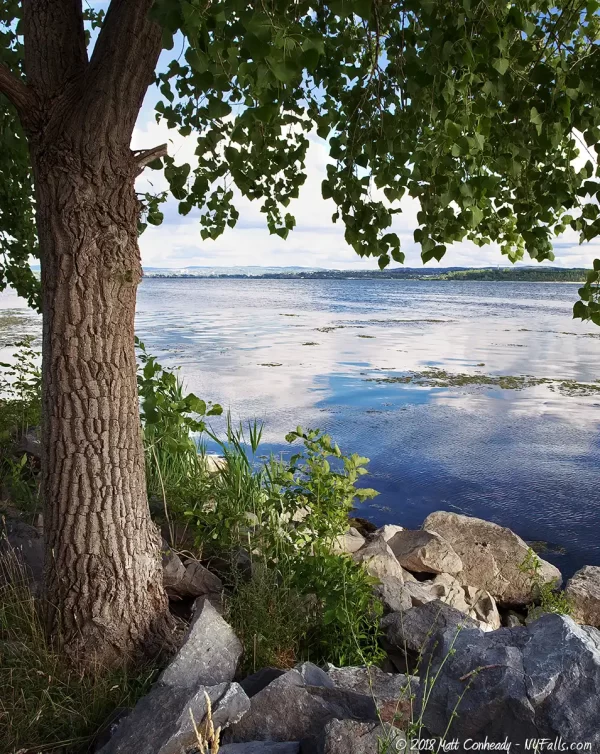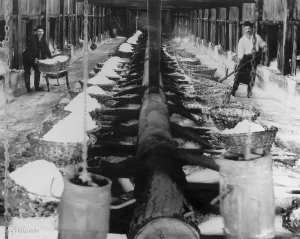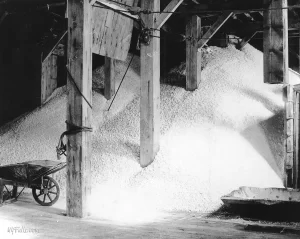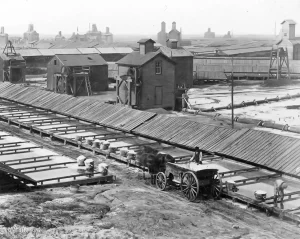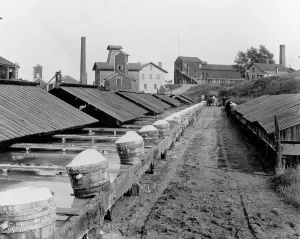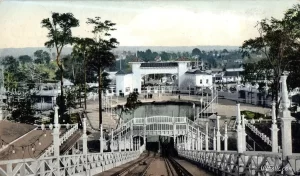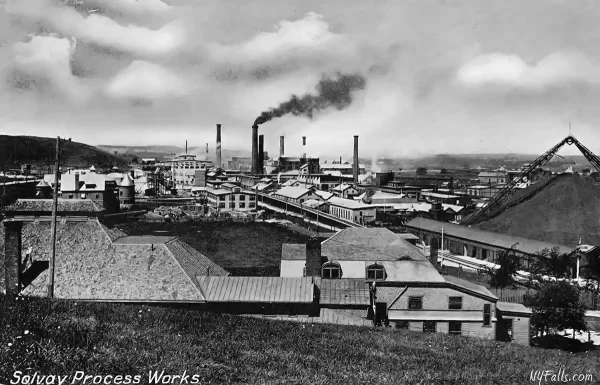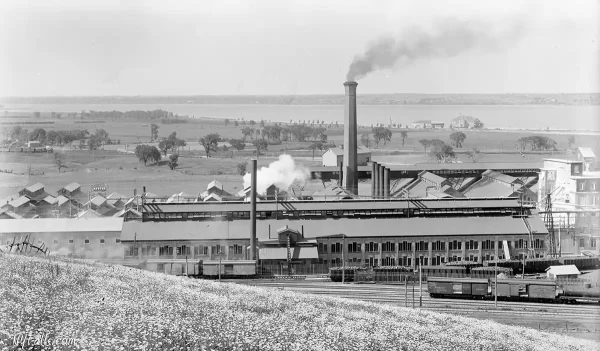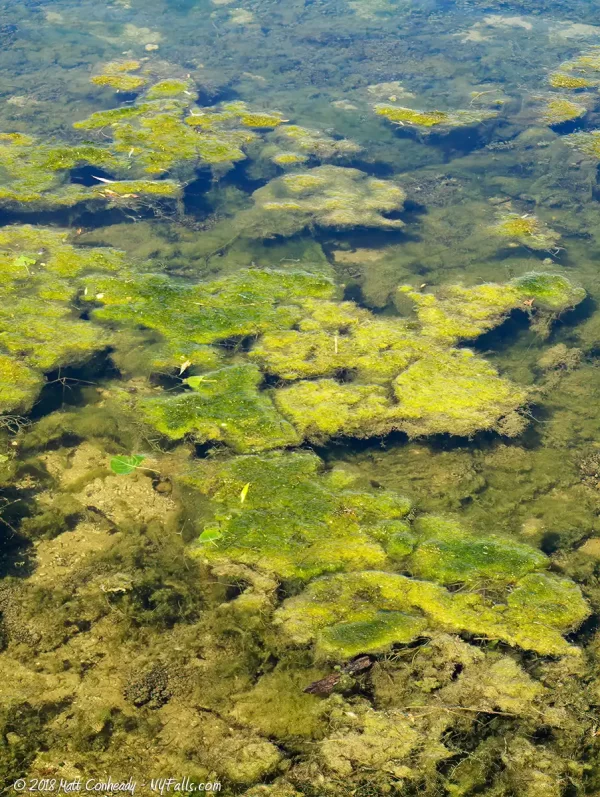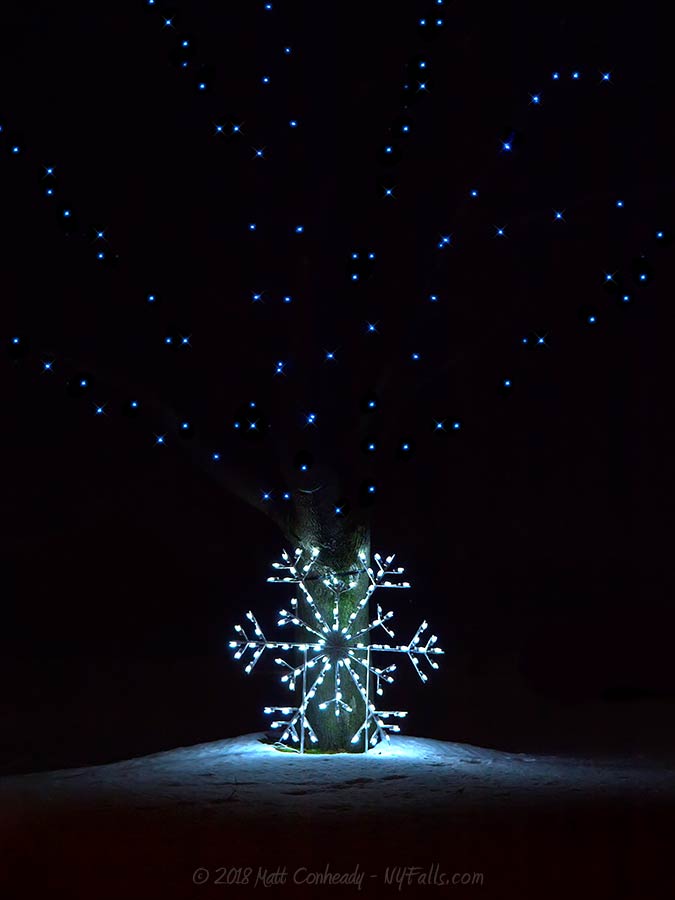Onondaga Lake

Location: Greater Syracuse, Onondaga County, New York.
Surrounding Communities: Liverpool; Solway; Syracuse.
Maps: Google map; Topographic; Contour.
GPS Coordinates:
- Southern inlet [Onondaga Creek at the Barge Canal Terminal]: N 43.06763 / W 76.17785
- Northern outlet [Lake outlet at the Erie Canal]: N 43.11516 / W 76.24228
Size:
- Area: 2,944 acres
- Length: 4.6 miles
- Max width: 1 mile
Max depth: 63 feet.
Volume: 35 billion gallons.
Water Quality: Poor/contaminated/not safe for recreational contact.
Water supply: Not used
Elevation: 111 feet
Directions: The New York State Thruway skims the northern end of the lake between exits 38 and 39. I690 runs down the west side of the lake, while Rt 370, the Onondaga County Parkway, runs down the eastern shore.

Weather
Description
Pronunciation: “On-on-dah-gah” From the Iroquois name meaning “on the hill”
Upstate New York, particularly the city of Syracuse, owes much of its success to this relatively small glacial lake. Although not so apparent today, Onondaga Lake was an industrial hot-spot for much of the twentieth century, with factories that fueled not only the local economy, but manufacturing across the state. Feeding from the Lake’s success as a natural resource, transportation hub and waste basin, the city of Syracuse grew around it. Today, the factories that once characterized Onondaga Lake as an industrial powerhouse have nearly disappeared, leaving behind environmental scars that have earned it a reputation for being one of the most polluted lakes in North America.
Onondaga Lake runs from southeast to northwest, with the city of Syracuse engulfing the southern end. Destiny USA Mall and the city’s wastewater treatment plant (METRO) are the dominant features here along the inlet at Onondaga Creek, which contributes most of the inflow to the lake. Along the eastern shore lies the village of Liverpool (pop. 2500) and the largely developed portion of Onondaga Lake Park. The park wraps around the north end, known as Long Branch Park, where the New York State Thruway skims the top of the lake and crosses the outlet at the Seneca River and Erie Canal.
Onondaga Lake Park’s trails extend partly along the western shore, past the hamlet of Lakeland (pop. 2800) and stop abruptly at the village of Solvay (pop. 6400). Here the park ends at the Solvay waste beds, a series of contaminated wells of calcium and chloride waste that make up over 1,000 acres along Ninemile Creek; one of the lake’s major tributaries. Just beyond the waste beds is the New York State Fairground complex, the permanent host for the Great New York State Fair and numerous other major events.
History
Early history
Like many of the lakes in this region, including the Finger Lakes, Onondaga Lake started as an ancient limestone river valley that was gouged out by massive glaciers. The deep post-glacial basin was subsequently filled with glacial melt-water and formed the Lake. The land surrounding Onondaga was once the home to the Onondaga tribe of the Iroquois Confederacy. The tribe claims that the pact that formed the massive confederacy was struck along its shore, representative of the lake’s connected waterways and importance to transportation across the confederacy’s land.
Salt and the growth of Syracuse
In 1654, the Onondagas led French explorers to natural salt springs near the lake, which in turn brought upon a French settlement and the construction of Fort Sainte. Marie Degannentaha on the eastern shore in 1656. Although the settlement did utilize the springs, it wasn’t until the late 1700s that commercial salt production began here. Brine from the salt springs was evaporated in large pools and table salt was easily harvested and sold for large profits. It was then that people began to realize the commercial potential of this region. Syracuse began to grow rapidly, mostly due to salt production and the businesses that supported it. Industrial development already began to shape the lake when the northern outlet was dredged in 1822 to open the waterway to the Seneca River, and eventually the Erie Canal system. The dredging lowered the water level and dried up the wetlands that once covered portions of present-day downtown Syracuse. The arrival of the canal in the early 1800s connected the lake with the rest of the state and allowed the far reaching export of Syracuse salt. The canal was known as “the ditch that salt built,” primarily due to taxes applied to Onondaga salt to fund the westward expansion of it. When the canal opened up Onondaga salt to neighboring regions, Syracuse became known as “Salt City.”
It wasn’t just salt that brought people to Onondaga. Several of the lake’s geological and chemical conditions, coupled with numerous tributaries result in a low level of rooted aquatic plants. Less plant coverage in the lake means that smaller fish have few places to hide. The result is a smorgasbord for large predatory species like salmon, whitefish, turbot and sturgeon. Supporting a large commercial fishery for nearly a century, Onondaga lake was known all over the state for its prized Atlantic Salmon and Cisco (known to many as Onondaga Whitefish).
The late 1800s brought the tourism industry. Lavish resorts, beaches and amusement parks, like the massive Iron Pier Resort that once stood where the Destiny USA stands today, catered to the well-off Syracuse residents who needed a break from bustling city life. The Central NY Railway brought tourists in from afar by the thousands and steamers crisscrossed the lake hauling them from resort to resort. The Onondaga lakefront was on its way to becoming one of the premier resort destinations in New York.
Chemical manufacturing
In the late 1800s, the discovery of rock salt deposits throughout much the Great Lakes region made the less-efficient brine extraction method used at Onondaga less attractive and the Syracuse salt industry went into decline. It wasn’t long before a new industry sprang up in its place with the opening of the Solvay Process Company’s soda ash plant on the western shore in 1884. The Onondaga Lake site provided the ideal environment and resources needed for the Solvay process of creating Soda Ash: salt water from the nearby springs, calcium carbonate from the surrounding limestone bedrock and quick and guiltless disposal of waste into the Lake. With immediate access to the resources needed, the soda ash plant flourished.
Soda ash, also known as sodium carbonate (Na2C03), is a form of salt that has a wide variety of industrial uses. Commonly it is utilized in the manufacture of glass, paper, photo-chemicals, soaps and detergents, as a pH regulator in a variety of chemical processes, and in the treatment of water. Upstate New York industry giants such as Kodak (film), Corning (glass) benefited greatly from this local source of soda ash. The Solvay process (simply put) takes the sodium molecules from table salt (sodium chloride) and combines them with the carbonate molecules from calcium carbonate limestone. The problem is that the process leaves leftover calcium and chloride molecules, which either need to be disposed of, or used to create other chemicals. Chloride, in the right mixture, is highly toxic. The plant dumped millions of pounds of calcium and chloride rich byproducts into the lake each day; increasing the salinity of the water and decreasing the dissolved oxygen.
Everyone’s Toilet
The arrival of the soda ash industry resulted in a manufacturing boom along Ninemile Creek on the western shore of the lake. The New York Central Rail and a branch of the Erie Canal ran through here and provided easy distribution of products while the creek and lake, served as an inexpensive way to get rid of industrial waste. The industrial boom brought upon radical population growth in the city, which began exceeding its municipal waste handling capacities. Syracuse had always dumped its raw sewage into Onondaga Creek, which, in turn, ended up in the lake, but it was now dumping massive quantities, more than the lake could naturally handle. The raw sewage increased nitrate and phosphorous concentrations in the water, and led to massive algae blooms that led to massive fish die-offs. By the late 1890s, the renowned Onondaga Lake commercial fishery ended as fish populations dwindled. City sewage also added potentially dangerous microorganisms to the lake and made the whole basin stink.
The declining condition of the lake did not stop the factories. With limitless resources and free waste disposal, they continued to prosper into the 20th century. With waste products piling up and new potential on the horizon for utilizing that waste, the Solvay plant began storing waste in shallow wells along Ninemile Creek. These wells eventually covered over a thousand acres of watershed and when they were filled, the plant built the dikes higher to store more. The Solvay Process Company (SPC) added a new plant in 1918 to produce chlorine and a variety of organic chemicals (using some of the soda ash byproducts). As a result, hundreds of thousands of pounds of toxic mercury were dumped into the lake among other various chemicals. SPC wasn’t the only culprit; numerous other plants dumped solvents and organic chemicals such as benzene and PCBs. By the 1930’s the massive resorts and amusement parks, struggling for years to give customers a reason to visit the polluted Lake, could not compete with more appealing Adirondack and Catskill resorts, and closed for good.
A void left by disappearing establishments on the eastern shore was quickly filled by park land in 1933, which is now part of present day Onondaga Lake Park. But this was not a sign of change in the industrial attitude towards the Onondaga watershed. Dumping continued unchecked and by the 1940’s, the lake’s primary function was the disposal of industrial and municipal waste.
Environmental devastation
Onondaga Lake’s small size and large, numerous tributaries allow it to recycle its water 4 times a year. This means that if you were to fill the lake completely with grape juice, it would take about 3 months for the lake to flush out all the juice (that’s 35 billion gallons) and replace it with fresh water. This is very fast for a large lake. Unfortunately, the amount of dumping that took place outweighed the speed at which the lake could renew. Additionally, tributaries like Ninemile Creek, which would normally carry in fresh water, passed through acres of contaminated waste beds, picking up solvents along the way. Heavy metals (such as mercury) and organic compounds settle into sediments, get soaked up by plant life and enter the food chain where they accumulate. Even the seemingly harmless calcium Solvay waste coats the lake shores with calcium salt deposits. The mess is not contained by the Lake’s boundaries: dissolved pollutants, such as chloride, eventually make their way up the Seneca and Oswego Rivers and into Lake Ontario.
In 1940, swimming in Onondaga Lake was banned and the public started to take notice. An accident in November of 1943 furthered concerns when a Solvay waste bed dike (at the time owned by Allied Chemical Corporation), failed. Nearby roads, homes and part of the State Fairgrounds flooded with tons of toxic Solvay waste. Unfortunately, at the time there were no laws against dumping toxic waste. Little could be done about what was going on here. Factories continued dumping without restrictions and the lake grew worse. The city of Syracuse constructed a waste water treatment facility on the south shore to tame the flow of sewage into the Onondaga Creek, but it was a far cry from what was needed for the general health of the watershed. By the 1950s, the once-celebrated fishery of over a hundred types of fish was down to a dozen or so species, dominated by pollution-tolerant carp. Fishing was outright banned in 1970.
Environmentalism wins
It was the environmental movement of the 1970s (yes, those tree-huggers) that pushed for direct government regulation of industrial waste disposal. The Federal Water Pollution Control Amendments in 1972 and the Federal Clean Water Act in 1977 sparked a revolution in toxic waste regulation and brought upon the era of cleanup at Onondaga Lake. Community, state, and federal pressure began to weigh in on industrial plants that could not handle their toxic waste other than dumping it into lakes and rivers. Although mercury releases declined dramatically in the 1970s as its affects on the environment became more understood, regulation and the threat of fines and lawsuits made its control a priority.
In 1986 Allied discontinued soda ash production at Onondaga. That same year, catch and release fishing was reinstated. Chlorine production ceased two years later. In 1989, the lake was deemed an “inactive hazardous waste site” and a threat to public health by the state of New York, which filed a lawsuit against Allied Chemical for cleanup responsibility of the watershed. Under a court-mandated agreement, an initial cleanup plan was put into place. The Bridge Street chlor-alkali plant, owned by LCP-Hanlin, was shut down due to illegal mercury dumping in 1988.
In 1994, the federal government, via the Environmental Protection Agency also classified the lake as a public health threat and qualified it for federal assistance through the Superfund Act. In January of 1998 the Amended Consent Judgment was signed and required the county to take action to meet water quality standards for discharge of wastewater into Onondaga Lake through the METRO plant. It took over twenty years, but finally all of the legal pieces were in place to begin restoration and continued protection of the lake and its watershed.
Cleaning up takes time
The New York State DEC and Honeywell (the current owner of the Allied Chemical properties) came together in the early 2000s to produce a comprehensive plan for the clean-up and remediation of Onondaga Lake and surrounding properties. The 15-year, $380 million plan received federal approval in 2007, but much of the initial steps began in the 1990s. The complex plan is divided into three stages:
Stage one : Halt source contamination and increase monitoring.
The problem: Much of the chemical contamination does not reside in the lake water itself, but in waste beds along Ninemile Creek and soil sediments on the western shore. Wastewater discharge from the Syracuse sewage treatment plant (METRO) is also a huge contributor. In order to know if efforts are working as planned, the pollution levels and overall health of the lake and its tributaries have to be monitored regularly.
The plan: Honeywell has spent millions to clean up old plant sites and built a $20 million groundwater treatment plant to scrub sediments of contaminants. Syracuse’s METRO water treatment plant has initiated upgrades but still falls short of state water quality standards. Phosphate detergents have been banned within the watershed. The amount of sediment entering the lake through Onondaga Creek has been reduced by remediation of the Tully mudboils. Thorough water quality surveys by the Army Corps of Engineers have taken place (1992) and the county will monitor water quality regularly.
Stage two : Dredge the lake’s bottom to remove contaminated sediments.
The problem: Much of the contamination, specifically mercury, has settled into the lake’s sand and mud-covered basin. It’ll stay there until absorbed by plant or animal life and then carried through the food chain.
The plan: Not all of the lake will be dredged and not all of the contaminated sediment will be removed. Lake sediments in the southwest portion near the wastebeds and Ninemile Creek will be dug up and brought offsite for treatment or containment. One of the old Solvay waste beds will be used as a “Sediment Consolidation Area” to store contaminated sediment.
Stage two : Cap and seal the lake’s bottom.
The problem: Since the dredging stage is only a partial solution for contaminated sediment, the remaining sediment will need to be isolated from the lake’s water and organic content.
The plan: A barrier wall will be built underground in the shore to cut off the water table that runs through the contaminated waste beds and into the lake. A 425 acre cap of sand and stone will cover contaminated sediments on the lake bottom. The thickness of the cap will range from 2.5 to 10 feet thick. Installation of the cap will require sections of the lake to be isolated and drained temporarily. It is speculated that the cap will provide an improved substrate for lake plant life.
Signs of hope
Yearly, millions still visit the lake to take in the sights and take advantage of the miles of trails, bike paths, fishing opportunities and wide variety of recreational activities available. An increasing number of boats can be seen crossing the waters each summer seeking out the best fishing spots. Even in winter, Onondaga Lake Park is packed with visitors who come to cross country ski, sled, or check out the dazzling Lights on the Lake holiday display. From the trails that wrap around Onondaga Lake Park, which encompasses nearly three quarters of the lake, the waters look calm and harmless. The park’s well-kept shoreline gives visitors a sense of progress to the clean-up efforts. Additionally, the introduction of the invasive zebra mussel has helped clear out the lake’s cloudy waters.
There is a lot of hope for the restoration efforts of the lake, and it seems to be progressing quicker than expected. Oxygen levels are steadily increasing and as a result, biodiversity of the lake’s waters is improving. Recently 50 species of fish have been reported to be inhabitants. But let’s not begin to assume that the lake is back to normal, or no longer a threat. Although positive signs have appeared, such as the lifting of the eating ban on fish (1999), even that carries a warning. High mercury levels limit eating to certain species and caution against anyone under 13 or pregnant/nursing should not consume any fish from the lake at all. Extended physical contact with the lake’s waters is also considered a health hazard. Swimming is still banned. An Onondaga-caught fish fry, doesn’t sound too appealing once you take that into account.
Wastewater discharge from Syracuse’s METRO facility has improved, but still does not meet state water quality standards. The excess of phosphates continues to promote algae growth and causes large mats to cover portions of the lake, choking off light and oxygen. Turbid water from Onondaga Creek masks the sunlight and hinders the growth of rooted plants. You can see in the satellite image below, the high concentration of cloudy sediment near the southeast end of the lake. The city of Syracuse has explored plans to turn the waterfront bordering the city into a commercial harbor and waterfront, but until clean-up of the southern end progresses there may not be much appeal.
One of the apparent signs that something is amiss is the obvious lack of development of the shoreline. New York does in fact have a few large lakes with no residential or commercial development whatsoever. Hemlock and Canadice Lakes, which have been preserved as a water source for the city of Rochester are nearly pristine. Urban lakes without bordering homes, cottages or resorts are virtually unheard of here. Onondaga Lake has little besides the park, Destiny USA complex and waste water treatment plant. Luckily, extending the park to fill the void has been relatively cheap and is certainly a welcomed preservation method. Onondaga Lake Park is one of the most visited lakefront parks in the state and is cherished by the community. While the lake has reached standards set by the EPA and DEC by 2017, it still has long-term scars and complete rehabilitation of the lake will take additional time and continual care and monitoring. In 2022, it was declared by backers of the clean-up effort that the lake is the cleanest it has been in 100 years. Still, contaminated sediments still lock toxins below the lake.
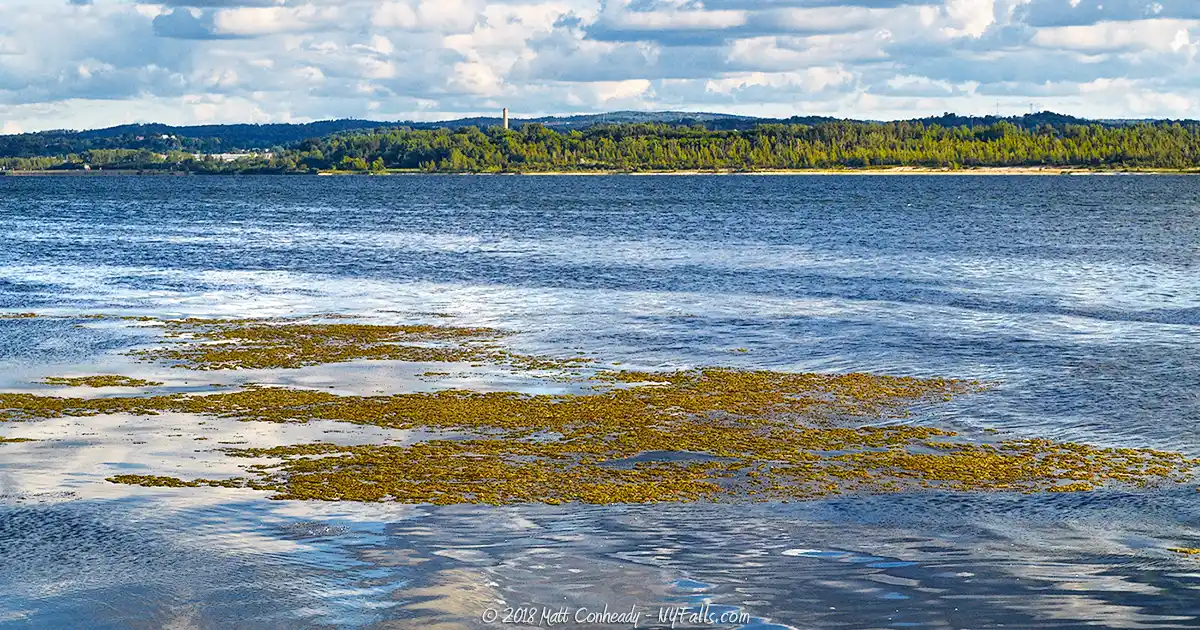
Onondaga Lake Park
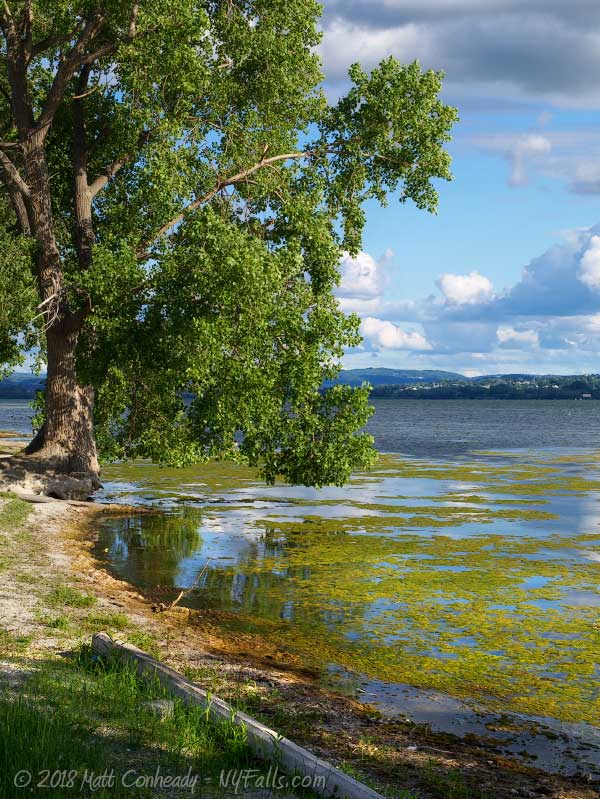 This is an extremely popular park and probably one of the most frequented for its size in all of upstate New York. Entwined with tens of miles of leisurely trails; it’s frequented by the wheeled and grounded traveler alike. A beautifully landscaped footpath extends along the shore for nearly 5 miles offering relaxing benches and scenic views along the way. Aside from the paths, visitors come to explore the lake’s history with the Salt Museum, Sainte Marie among the Iroquois village exhibits; experience the butterfly garden, play in the skate park, various ball fields and game courts.
This is an extremely popular park and probably one of the most frequented for its size in all of upstate New York. Entwined with tens of miles of leisurely trails; it’s frequented by the wheeled and grounded traveler alike. A beautifully landscaped footpath extends along the shore for nearly 5 miles offering relaxing benches and scenic views along the way. Aside from the paths, visitors come to explore the lake’s history with the Salt Museum, Sainte Marie among the Iroquois village exhibits; experience the butterfly garden, play in the skate park, various ball fields and game courts.
Kids enjoy playing on the massive Wegmans Playground and families can take part in many of the various daily fitness programs offered at the park. The park encourages you to be active during your visit and they offer bicycle, kayak and game rentals while you are there. Have seven people in your family? They have a bike built just for you. The family dog isn’t to be left out: the Wegmans Good Dog park is a great place to play with your dog in a safe and stimulating environment.
Onondaga Lake Park is great for picnicking and partying too. Seven well-equipped shelters throughout the park cater well to larger get-togethers, while a concentration of picnic tables and grills in the well shaded Willow Bay are the perfect setting for a peaceful meal.
The park just has too many great features to mention. So, we summarized the big ones here:
The Griffin Visitor Center / Park office
This information center offers bike, skate and game equipment rentals and is surrounded by shuffleboard and bocce ball courts, a sand volleyball court, two baseball fields and an open field. The playground and skate park are also nearby. With ample parking and proximity to the lakeshore and recreation trails as well as Liverpool restaurants. (location)
East Shore Recreational Trail
The East Shore Recreational Trail is as smooth as it is wide. This 2.5 mile long trail is reserved for skaters and cyclists. The tram also runs on this pathway.
Shoreline Walking Trail
The Shoreline Walking Trail is a leisure foot path that hugs the shoreline and is spotted with restrooms and benches. The only wheels allowed here are those attached to a chair.
The Wegmans Playground
Located near the Visitor Center, this state-of-the-art playground covers 35,000 sq. ft. and includes all the favorites, including a playhouse, sand boxes, slides, ladders, see-saws and monkey-bars as well as some new contraptions we never had when we were kids. (location)
The Skate Park
Located near the Visitor Center, this hodgepodge of smooth pipes, rails, hips and gaps is a great place to hone or challenge one’s BMX, inline or skateboard abilities. Rates and schedule. (location)
The Salt Museum
What better way to bore your children than to bring them to a museum dedicated to salt? It was the salt industry that was responsible for the early growth of the city of Syracuse and the museum is a field-trip pilgrimage for almost all area students. For adults and history buffs, it’s actually pretty interesting. Admission is free. (location)
Willow Bay
Is the popular picnicking section of the park. A large pavilion and numerous tables and grills are dispersed through the trees here. (location)
The Butterfly Garden of Hope
This garden and gazebo are a tribute to all that have died (all, ever, apparently). Despite that, it is a popular location for wedding ceremonies. Visit in spring to observe a variety of native butterflies. More information. (location)
Long Branch Park
Long Branch Park is the northern section of the park that is isolated by the Thruway. Park trails pass through here and there is a hand boat launch, but the pavilions and picnic facilities here are generally reserved for parties and other events. There’s also a ball park here and a decent hill for winter sledding. Long Branch Park used to be a large amusement park in the early 1900s. Its carousel is now housed on the other side of the lake in the Destiny USA mall. (location)
Skä•noñh – Great Law of Peace Center
Skä•noñh – Great Law of Peace Center was originally a recreation of the French settlement, the first European settlement in this area, that stood at this very location from 1656 to 1658. It was closed down in 2011, and re-opened as Skä•noñh – Great Law of Peace Center. More information. (location)
Wegmans Good Dog Park
Wegmans Good Dog Park is one of the few dog-dedicated playgrounds in central New York. Here you can take your best friend off their leash and let them play with others or with the small obstacles and watering stations. Yes, there are fire hydrants. More information. (location)
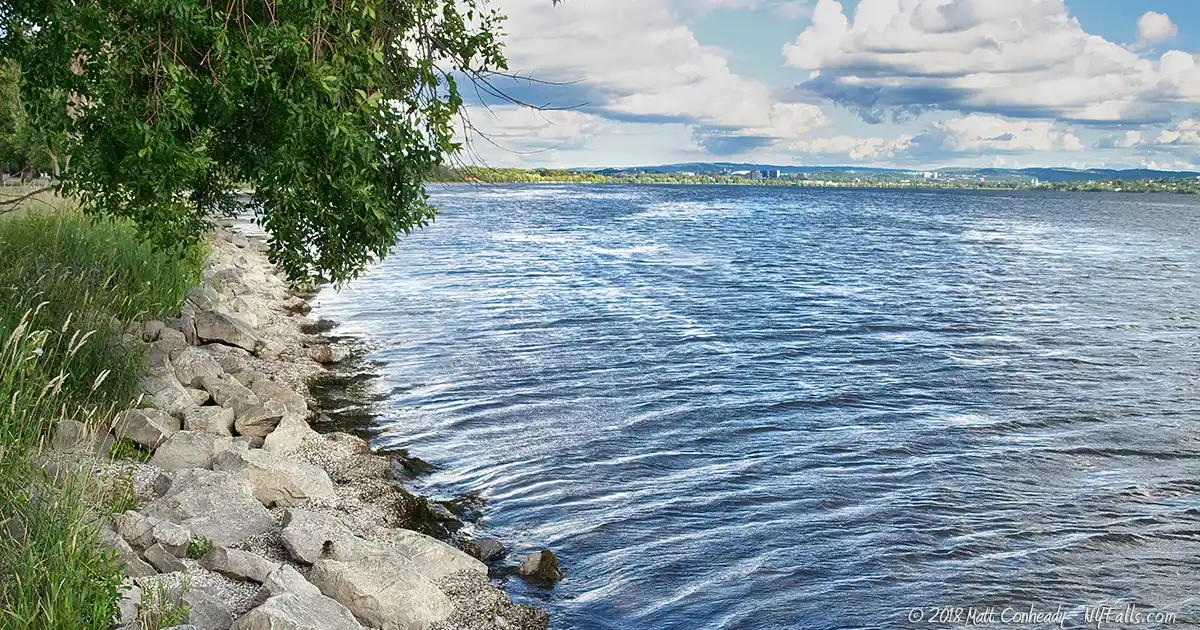
General Park Information
Seasons/Hours: Year-round. From dawn until dusk.
Directions: Eastern shore entrances are off of Rt. 370; on Willow St., on Long Branch Rd. just north of the Thruway; at Cold Springs Rd.; and at the end of Dwight Park Drive.
Parking: Plenty. Lots are located near the visitor’s center, here, here, here and here. Marina parking is here. Parking at Willow Bay here. Parking for Long Branch Park is here and here. Parking at Cold Springs is here.
Pets: Onondaga Lake Park is a pet-friendly park. All pets are required to be on a leash and please carry proof of inoculation with you at all times. Pets are not allowed on the Shoreline Trail, but dogs are welcome at Wegmans Good Dog Park at Long Branch Park.
Admission: Admission is free, but there are fees for pavilion, marina and equipment rentals. Fees are listed here.
Handicap accessibility: Yes (most trails and facilities).
Swimming: No.
Boating: A full-service marina is stationed on the eastern shore, not far from the information center. Launch fees vary. There is a public canoe and kayak launch on the Seneca River outlet in Long Branch Park.
Accommodations: Restrooms; picnic tables; grills; pavilions (7); benches; hiking trails; bike and rollerblade paths; playground; museums; dog park; information center; skate park; playing fields; open fields; game courts (bocce, shuffleboard); bus stop; bicycle and skate rentals; equipment rentals; kayak and row boat rentals; tram service.
Park Map: Official Trail Map.
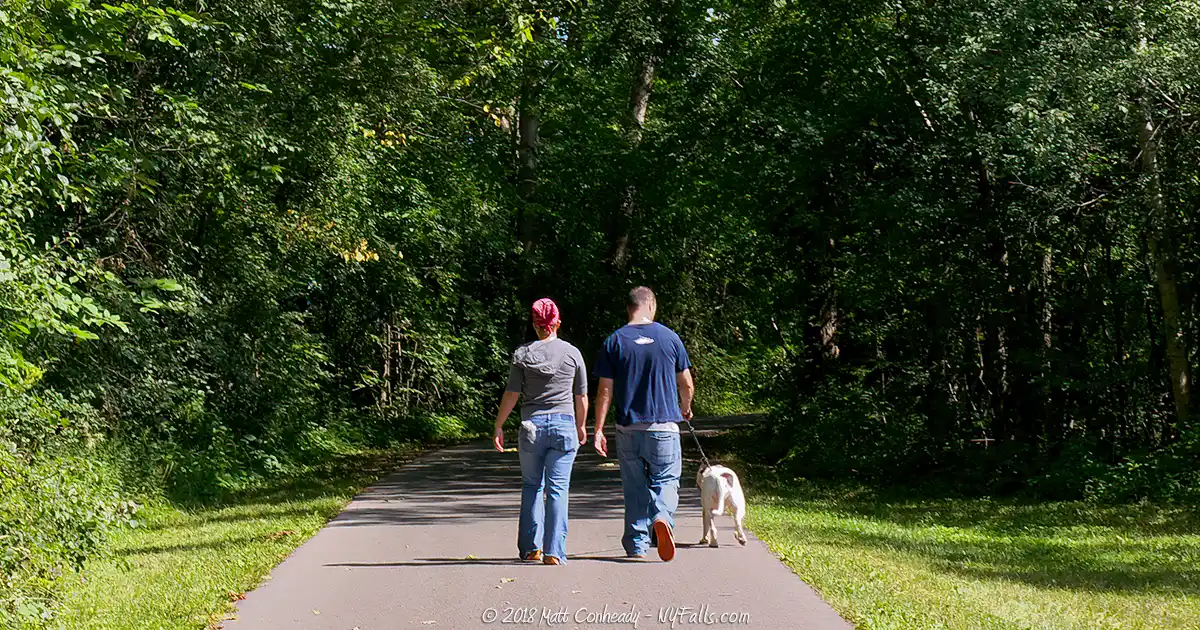
Interactive Map
Fishing Information
Do not eat the fish from Onondaga Lake. If you catch a tagged fish, please record the tag number, length, weight, and location found, and report this information to OCDWEP (315) 435 – 2260
Common species
Bluegill; Pumpkinseed; Smallmouth Bass; Largemouth Bass; Yellow Perch; Common Carp; Channel Catfish; Brown Bullhead; Crappie; Walleye; Brown Trout.
Best fishing spot
Near the lake outlet at the Long Branch section of the park (northwest).
Fishing conditions
For current fishing information a fishing hotline is available at Central New York Fishing Hotline or by calling (607) 753- 1551.
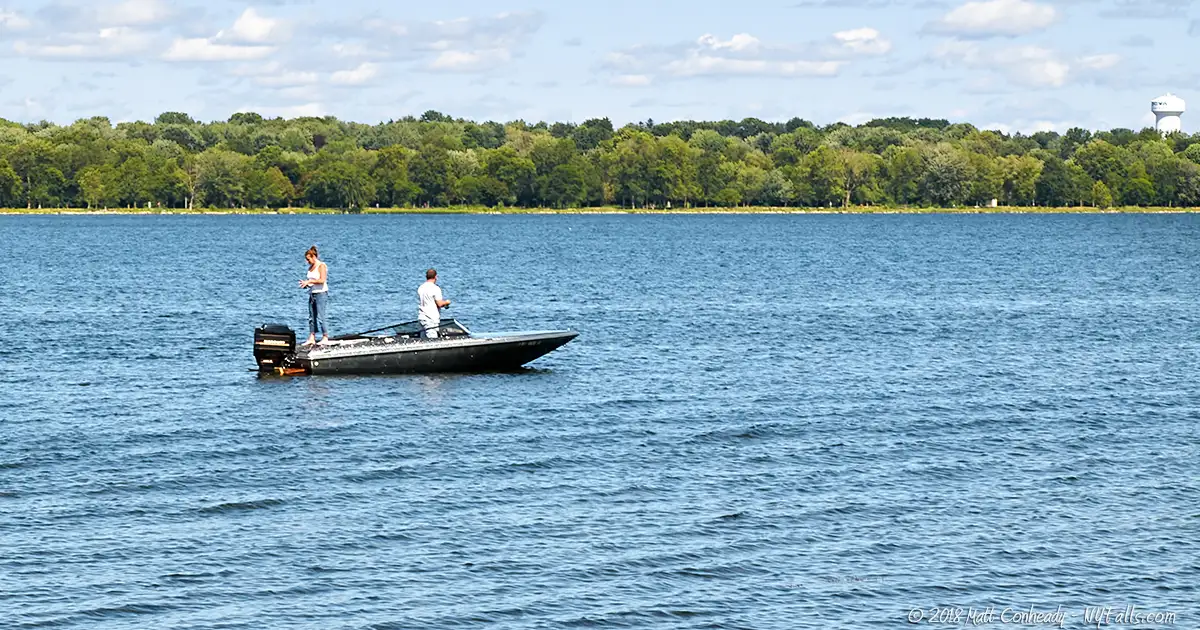
Interesting Stuff
The Fair
The Great New York State Fair is the annual 12-day showcase of agriculture, education, industry, and technology, but most people come to eat classic upstate cuisine and buy cheap stuff. The fairgrounds are situated on the western shore of the Lake.
Lights on the Lake
Cars line up for a chance to drive very slowly through the annual Lights on the Lake holiday light display. Millions of lights arranged in colorful and animated displays light up the paved pathways of the park, while holiday music plays on the radio. It runs from late November to the first week in January.

Who to Contact
General enviromental concerns:
NYSDEC Region 7 Fisheries
1285 Fisher Ave. Cortland, NY 13045
Phone: (607) 753-3095
E-mail: [email protected]
Park Property
Onondaga County Parks
Phone: (315) 453-6712
[email protected]
Lake Water Quality
Onondaga County Department of Water Environment Protection
650 Hiawatha Boulevard West
Syracuse, New York 13204-1194
Phone: (315) 435 – 2260



